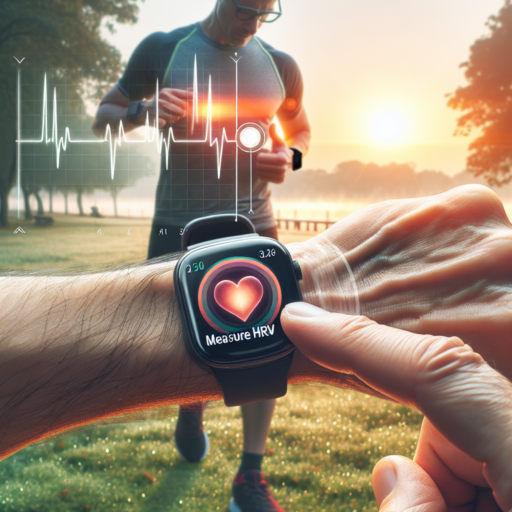Introduction to Heart Rate Variability (HRV)
Understanding the fundamental aspects of Heart Rate Variability (HRV) is crucial for anyone interested in enhancing their overall wellbeing and athletic performance. HRV refers to the variation in time intervals between consecutive heartbeats. Contrary to what some might believe, a healthy heart does not tick like a metronome. Instead, its rhythm fluctuates, a sign of the body’s adaptability and resilience to stress. This variability offers a window into the autonomic nervous system’s (ANS) functionality, hinting at the balance between its sympathetic ‘fight or flight’ and parasympathetic ‘rest and digest’ branches.
HRV has garnered attention from researchers and health practitioners alike for its predictive capabilities. Higher variability generally indicates a strong, responsive cardiovascular system, while lower variability can signal stress, fatigue, or underlying health issues. It’s a non-invasive metric that can be tracked through wearable technology, making it accessible for both athletes aiming to optimize performance and individuals focused on stress management and health optimization.
The application of HRV extends beyond mere measurement. By analyzing these variations, individuals can make informed decisions about training intensity, recovery needs, and stress management techniques. Understanding one’s HRV patterns can lead to personalized health interventions, fostering an environment where holistic health and peak performance can thrive.
Why Measure Your HRV?
Measuring your Heart Rate Variability (HRV) is becoming increasingly recognized as a critical health metric. HRV, the variation in time between each heartbeat, is a mirror of your autonomic nervous system and offers a nuanced window into your overall well-being and stress levels. Understanding your HRV can guide you in managing stress, optimizing your fitness routine, and improving your health.
First and foremost, HRV is an excellent indicator of physical fitness and heart health. A higher HRV suggests a robust heart capable of efficiently adapting to varying stress levels and physical demands. For athletes and fitness enthusiasts, tracking HRV can provide valuable feedback on recovery status and readiness for high-intensity training, assisting in optimizing performance without overtraining.
Furthermore, HRV measurement can also play a pivotal role in stress management and prediction of health issues. It’s no secret that prolonged exposure to stress can have detrimental effects on the body, contributing to chronic health conditions such as hypertension, heart disease, and even mental health challenges like anxiety and depression. By monitoring changes in HRV, individuals can gain insights into their stress and recovery levels, enabling early intervention and prevention strategies to counteract negative health impacts.
How to Measure HRV Accurately
Measuring Heart Rate Variability (HRV) accurately is pivotal for individuals looking to monitor their stress levels, recovery status, and overall heart health. Understanding the intricacies of HRV requires precision and attention to detail, ensuring that the data collected is both reliable and actionable.
Opt for Reliable Measurement Tools
Choosing the right tool is the first step in accurately measuring HRV. Devices like smartwatches and chest straps are commonly used due to their accessibility and ease of use. However, it is crucial to select devices that are scientifically validated for HRV measurements to ensure accuracy.
Consistency is Key
Maintaining consistency in the measurement conditions is vital for accurate HRV assessments. This includes measuring HRV at the same time each day, preferably in a restful state such as upon waking up. Factors such as physical activity, caffeine intake, and stress levels can significantly influence HRV readings, making it essential to control for these variables as much as possible.
Understand the Metrics
An accurate measurement of HRV goes beyond the raw numbers; understanding the metrics and what they signify is crucial. Key HRV indicators include RMSSD (Root Mean Square of Successive Differences) and SDNN (Standard Deviation of NN Intervals), each offering insights into the autonomic nervous system’s function. Comprehending these metrics allows for a more nuanced interpretation of HRV scores, facilitating informed health and lifestyle decisions.
The Best Tools and Devices for Measuring HRV
Heart Rate Variability (HRV) has emerged as a crucial metric for assessing physical fitness, tracking recovery, and understanding stress levels. Choosing the right tools and devices to measure HRV can significantly impact your ability to accurately monitor this important biomarker. Below, we dive into some of the leading technologies and products in the field, highlighting their key features to help you make an informed decision.
Wearable Technology
At the forefront of HRV measurement, wearable technology combines convenience with precision. Devices like the Apple Watch Series 6 and the Garmin Fenix 6 stand out for their advanced sensors and algorithms, capable of providing real-time HRV scores directly on your wrist. These watches not only offer continuous HRV tracking but also integrate this data with other health metrics to give a comprehensive overview of your wellbeing.
Specialized HRV Sensors
For those looking for a more detailed analysis, specialized HRV sensors offer a solution. The Polar H10 Heart Rate Sensor, for example, is highly regarded for its accuracy and reliability. Worn around the chest, it uses ECG (electrocardiogram) technology to deliver precise HRV readings. This level of detail is particularly beneficial for athletes and fitness enthusiasts striving to optimize performance and recovery.
Ultimately, the choice of tool or device depends on your specific needs and goals. Whether you prioritize convenience and ease of use, or accuracy and detail, there’s a solution out there that can help you unlock the full potential of HRV monitoring. By utilizing these advanced technologies, individuals can take a significant step forward in managing their health and fitness.
Understanding Your HRV Results: What They Mean for Your Health
Your Heart Rate Variability (HRV) results can provide deep insights into your overall cardiovascular health and stress levels. Interpreting these results correctly is crucial for leveraging HRV as a tool for enhancing your wellbeing.
HRV measures the variation in time between each heartbeat, a metric that offers more than just insight into your heart’s rhythm. High HRV values generally indicate good cardiovascular fitness and a strong ability to handle stress. Conversely, lower HRV values may suggest a need for improved fitness or heightened stress levels. It’s essential to understand that HRV is influenced by various factors, including age, genetics, and lifestyles, such as sleep patterns and exercise habits.
Identifying patterns in your HRV results can inform your approach to managing stress and improving heart health. For example, if you consistently notice lower HRV readings, this might be a sign to increase relaxation and recovery activities in your routine. On the other hand, if your HRV is steadily high, you’re likely in a good state of health but should maintain your current lifestyle to continue supporting your heart health. However, it’s crucial to consider fluctuations in HRV as part of a broader context, taking into account other health metrics and personal circumstances.
Improving Your HRV: Tips and Strategies
Improving your Heart Rate Variability (HRV) is essential for enhancing your overall health, resilience, and stress management capabilities. As an indicator of the balance between your sympathetic and parasympathetic nervous systems, a higher HRV suggests a healthier, more adaptable cardiovascular system. Here, we delve into actionable tips and strategies to help elevate your HRV and, by extension, your well-being.
Focus on Consistent, Quality Sleep
One of the most effective strategies for improving your HRV is prioritizing high-quality sleep. A regular sleep schedule that consists of 7-9 hours of restful sleep per night can significantly impact your HRV positively. Ensuring your sleeping environment is conducive to rest, by maintaining a cool, dark, and quiet space, can enhance sleep quality and, subsequently, HRV.
Engage in Regular Physical Activity
Physical exercise is another cornerstone for boosting your HRV. Incorporating a mix of cardiovascular activities, strength training, and flexibility exercises can foster a better HRV by enhancing heart health and reducing stress levels. It’s important to balance exercise intensity and recovery, as excessive training without adequate rest can lead to the opposite effect.
By implementing these strategies consistently, you take vital steps towards not just improving your HRV but also elevating your overall health profile. Remember, while immediate changes might not be visible, persistence and consistency in these practices can yield significant long-term benefits.
HRV and Stress Management: Finding the Connection
Understanding the intricate relationship between Heart Rate Variability (HRV) and stress management is critical for developing effective coping mechanisms. HRV, a measure of the variation in time between each heartbeat, is closely linked to our body’s autonomic nervous system and its ability to handle stress. This variability is an indicator of our physiological resilience and the flexibility of our heart to respond to internal and external stress triggers.
Research has revealed that a higher HRV is associated with a greater ability to manage stress, suggesting that individuals with higher variability are better equipped to handle stressors without significant psychological or physiological detriment. This is because a higher HRV reflects a more robust balance between the sympathetic (fight or flight) and parasympathetic (rest and digest) branches of the autonomic nervous system. Such balance is crucial for stress management, as it indicates a person’s ability to adapt to stress efficiently.
Increasing one’s HRV, therefore, can be a powerful strategy in improving stress management capabilities. Techniques such as mindful meditation, deep breathing exercises, and regular physical activity have been shown to positively influence HRV. These practices not only enhance our ability to manage stress but also contribute to overall health and well-being by improving cardiovascular function and reducing the effects of stress on the body.
How Athletes Use HRV to Enhance Performance and Recovery
Heart Rate Variability (HRV) has become a critical tool for athletes aiming to optimize their performance and improve their recovery processes. By monitoring fluctuations in the time interval between heartbeats, athletes can gain valuable insights into their autonomic nervous system’s response to stress, exercise, and relaxation. This information empowers them to tailor their training and recovery strategies, ensuring they maintain peak physical condition.
Personalizing Training Plans
Athletes utilize HRV to customize their training schedules, ensuring that each session is aligned with their body’s current state of recovery. By identifying days when their HRV indicates a high level of readiness, athletes can schedule intense workouts, capitalizing on their body’s peak preparedness for hard, stressful sessions. Conversely, on days when HRV suggests a lower recovery state, athletes can focus on lighter activities or rest, preventing overtraining and reducing the risk of injury.
Enhancing Recovery Strategies
Beyond adjusting training loads, HRV is instrumental in improving athletes’ recovery techniques. Through HRV monitoring, athletes and coaches can evaluate the effectiveness of various recovery methods, such as sleep quality, nutrition, hydration, and stress management practices. For instance, an athlete might notice improved HRV scores after incorporating more restful sleep or specific nutritional adjustments into their routine, indicating a positive impact on their overall recovery and readiness for performance.
Incorporating HRV into an athlete’s routine encourages a more nuanced understanding of their body’s signals and how different factors influence their performance readiness and recovery capacity. This data-driven approach not only sharpens an athlete’s competitive edge but also promotes long-term health and resilience in their sporting career.
No se han encontrado productos.
Common Mistakes to Avoid When Measuring HRV
Measuring Heart Rate Variability (HRV) is an effective way to gauge wellness, stress, and overall heart health. However, certain pitfalls can lead to inaccurate readings, resulting in misleading conclusions about one’s health. Awareness of these common mistakes can enhance the accuracy of HRV measurements and enable individuals to make more informed health decisions.
Not Maintaining a Consistent Measurement Routine
One of the primary errors in measuring HRV is the lack of a consistent routine. The time of day, your activity levels prior to the measurement, and even your posture can significantly affect HRV readings. For reliable data, it is crucial to measure HRV under similar conditions each day, preferably during a quiet moment in the morning after waking.
Ignoring the Impact of External Factors
External factors such as caffeine intake, alcohol consumption, and exposure to stress can skew HRV measurements. To ensure accuracy, individuals should avoid these influences for several hours before taking measurements. This consideration helps in minimizing variables that can lead to inconsistent readings, thus rendering the HRV data more reliable and actionable.
Improper Use of Measurement Devices
Finally, incorrect usage of HRV measuring devices can significantly distort data. Whether it’s a wearable, a chest strap, or a mobile app, each device has specific guidelines that must be followed for precise readings. Ensuring the device is properly configured, positioned, and calibrated is fundamental to obtaining accurate HRV measurements. Not adhering to these guidelines can not only result in inaccurate data but also hinder one’s ability to track health progress accurately over time.
Future of HRV: Trends and Innovations in Measurement Technology
In the rapidly evolving field of health technology, Heart Rate Variability (HRV) stands out as a critical indicator of the autonomic nervous system’s functioning and overall well-being. As we delve into the future of HRV, there are several emerging trends and innovations in measurement technology that promise to revolutionize how we understand and manage our health. These advancements are poised to offer more precise, accessible, and comprehensive insights than ever before.
Integration of HRV in Wearable Technology
One significant trend is the increased integration of HRV measurement capabilities into wearable technology. Smartwatches and fitness bands are becoming more sophisticated, offering real-time HRV data tracking alongside traditional metrics like heart rate and step count. This integration means users can now monitor their stress levels, recovery status, and even predict potential health issues directly from their wrist. Such accessibility is making HRV data more relevant and actionable for everyday health management.
Advancements in Signal Processing Algorithms
Another pivotal development in HRV technology is the improvement in signal processing algorithms. These advancements allow for more accurate HRV readings by minimizing errors and artifacts in data collection. By leveraging machine learning and artificial intelligence, new HRV measurement tools can distinguish between physiological signals and noise with remarkable precision, thus offering a more reliable assessment of autonomic nervous system activity.
Personalized Health Insights Powered by HRV
Furthermore, the future of HRV technology is moving towards providing users with personalized health insights. By analyzing long-term HRV data, newly developed apps and software can identify individual patterns and make tailored recommendations for improving lifestyle and managing stress. This personalized approach not only enhances the user experience but also promotes more effective health and wellness interventions, making HRV a cornerstone in the future of personalized medicine.
These trends and innovations in HRV measurement technology are not just expanding the boundaries of what’s possible in health monitoring; they are fundamentally changing the way we approach personal wellness and preventive healthcare. As we continue to uncover the full potential of HRV, the future indeed looks promising for both individuals and healthcare providers alike.




